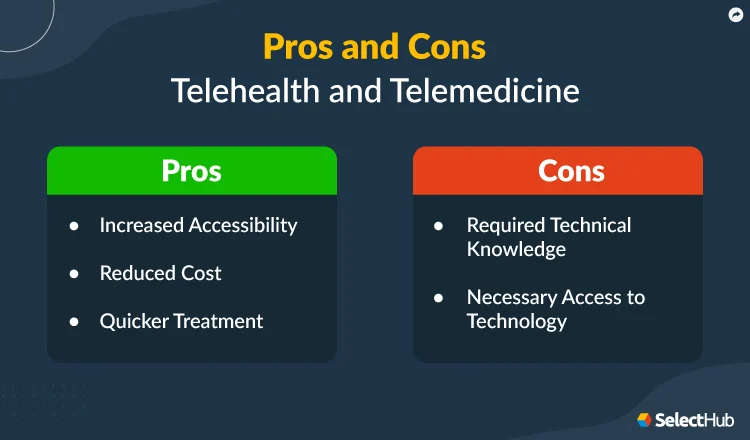The rise of telemedicine has brought about significant changes in the way healthcare is delivered, allowing patients to consult with healthcare providers remotely. This trend has both pros and cons that need to be carefully considered. On the one hand, telemedicine offers increased accessibility to medical care, especially for those in remote or rural areas. It also allows for more convenient and efficient appointments, saving time and reducing the need for travel. However, there are concerns about the quality of care and the potential for misdiagnosis in a virtual setting. Additionally, not everyone has equal access to the technology needed for telemedicine, creating potential disparities in healthcare delivery.
The Rise of Telemedicine
Telemedicine, also known as telehealth, is the use of digital communication and technology to provide remote clinical healthcare to patients. This can include virtual appointments, remote monitoring, and teleconferencing with healthcare professionals. The rise of telemedicine has been fueled by advancements in technology, increased access to high-speed internet, and the need for more convenient and efficient healthcare services.
Telemedicine has become especially popular in rural areas where access to healthcare facilities may be limited. It has also proven to be a valuable resource during public health crises, such as the COVID-19 pandemic, when in-person healthcare visits posed a risk of virus transmission. The convenience and accessibility of telemedicine have led to its widespread adoption and acceptance within the healthcare industry.
Pros of Telemedicine
One of the main advantages of telemedicine is increased access to healthcare services, particularly for individuals in remote or underserved areas. Patients can connect with healthcare providers without having to travel long distances, saving time and money. Telemedicine also allows for more frequent monitoring and follow-up care, leading to better management of chronic conditions.
Telemedicine can also improve overall healthcare efficiency by reducing wait times and streamlining administrative processes. It has the potential to lower healthcare costs for both providers and patients, as virtual appointments may be less expensive than in-person visits. Additionally, telemedicine can enhance collaboration among healthcare professionals, leading to better coordinated care for patients.
Cons of Telemedicine
While telemedicine offers many benefits, there are also some drawbacks to consider. One concern is the potential for misdiagnosis or inadequate treatment due to the lack of in-person evaluation. Certain medical conditions may require physical examinations or diagnostic tests that cannot be conducted remotely, leading to limitations in the scope of care.
Another challenge is the unequal access to technology and digital literacy among certain patient populations. Not everyone has access to high-speed internet or the necessary devices to participate in telemedicine appointments. This digital divide can exacerbate healthcare disparities and limit the effectiveness of telemedicine for underserved communities.
Regulatory and Legal Considerations
The rapid growth of telemedicine has prompted a need for updated regulations and legal frameworks to govern its practice. Licensing and credentialing requirements for healthcare providers delivering telemedicine services vary by state and country, creating complexities for interstate and international telehealth practices. Additionally, privacy and security concerns related to the electronic transmission of patient data must be addressed to ensure compliance with healthcare laws and regulations.
Reimbursement policies for telemedicine services are also an important consideration. Health insurance coverage for virtual appointments and remote monitoring varies widely, and reimbursement rates may differ from those for in-person visits. As telemedicine continues to evolve, policymakers and healthcare organizations are working to establish standardized guidelines and reimbursement structures to support its widespread integration into the healthcare system.
Technological Advancements in Telemedicine
The field of telemedicine is constantly evolving, driven by advancements in technology and digital healthcare tools. Innovations such as wearable devices, remote monitoring equipment, and telemedicine platforms with integrated electronic health records (EHR) have expanded the capabilities of telehealth services. These technologies enable real-time data collection, remote patient monitoring, and seamless communication between patients and healthcare providers.
Artificial intelligence (AI) and machine learning algorithms are also being integrated into telemedicine platforms to support clinical decision-making and predictive analytics. These advancements have the potential to enhance diagnostic accuracy, personalize treatment plans, and improve patient outcomes. As technology continues to progress, telemedicine is likely to become even more sophisticated and integrated into mainstream healthcare delivery.
Patient Satisfaction and Quality of Care
Studies have shown that many patients are highly satisfied with telemedicine services, citing convenience, reduced wait times, and the ability to access care from the comfort of their own homes as key benefits. Telemedicine also offers opportunities for improved communication and engagement between patients and their healthcare providers, leading to better patient education and self-management of health conditions.
However, ensuring the quality of care in telemedicine settings requires ongoing evaluation and monitoring. Healthcare providers must maintain high standards of clinical practice and communication skills in virtual environments. Establishing protocols for medical emergencies, referrals to in-person care when necessary, and continuity of care is essential for upholding the quality and safety of telemedicine services.
Ethical Considerations in Telemedicine
Telemedicine raises important ethical considerations related to patient privacy, informed consent, and the boundaries of the patient-provider relationship in virtual encounters. Safeguarding the confidentiality of patient information and obtaining informed consent for telemedicine services are crucial ethical responsibilities for healthcare providers and organizations.
Additionally, the potential for technological barriers and disparities in access to telemedicine services can raise ethical concerns about equitable healthcare delivery. Addressing these ethical considerations requires thoughtful policy development, professional guidelines, and ongoing ethical education for healthcare providers practicing telemedicine.
Future Trends in Telemedicine
Looking ahead, telemedicine is expected to continue expanding and integrating with traditional healthcare delivery models. The use of virtual reality (VR) and augmented reality (AR) technologies for telemedicine applications, the development of remote surgical procedures, and the expansion of telepsychiatry and mental health services are among the emerging trends in telemedicine.
Furthermore, the integration of telemedicine into preventive care, wellness programs, and population health management initiatives is anticipated to grow. As healthcare organizations and technology companies collaborate to innovate and address the evolving needs of patients and providers, telemedicine is poised to play an increasingly significant role in the future of healthcare delivery.
| Pros | Cons |
|---|---|
| Increased access to healthcare for remote or rural areas | Lack of in-person interaction between doctor and patient |
| Convenience for patients who have difficulty traveling to a doctor’s office | Potential for misdiagnosis without in-person examination |
| Reduced healthcare costs for both patients and providers | Privacy and security concerns with electronic health records |
| Ability to reach a larger pool of healthcare specialists | Limited ability to perform certain medical procedures remotely |
| Less exposure to infectious diseases in waiting rooms | Technological barriers for older or less tech-savvy patients |
The rise of telemedicine has both advantages and disadvantages. It provides increased access to healthcare for remote areas, convenience for patients, and reduced costs. However, it also lacks in-person interaction, has the potential for misdiagnosis, and raises privacy concerns. Overall, telemedicine offers a new way to access healthcare, but it is important to consider both the pros and cons.




